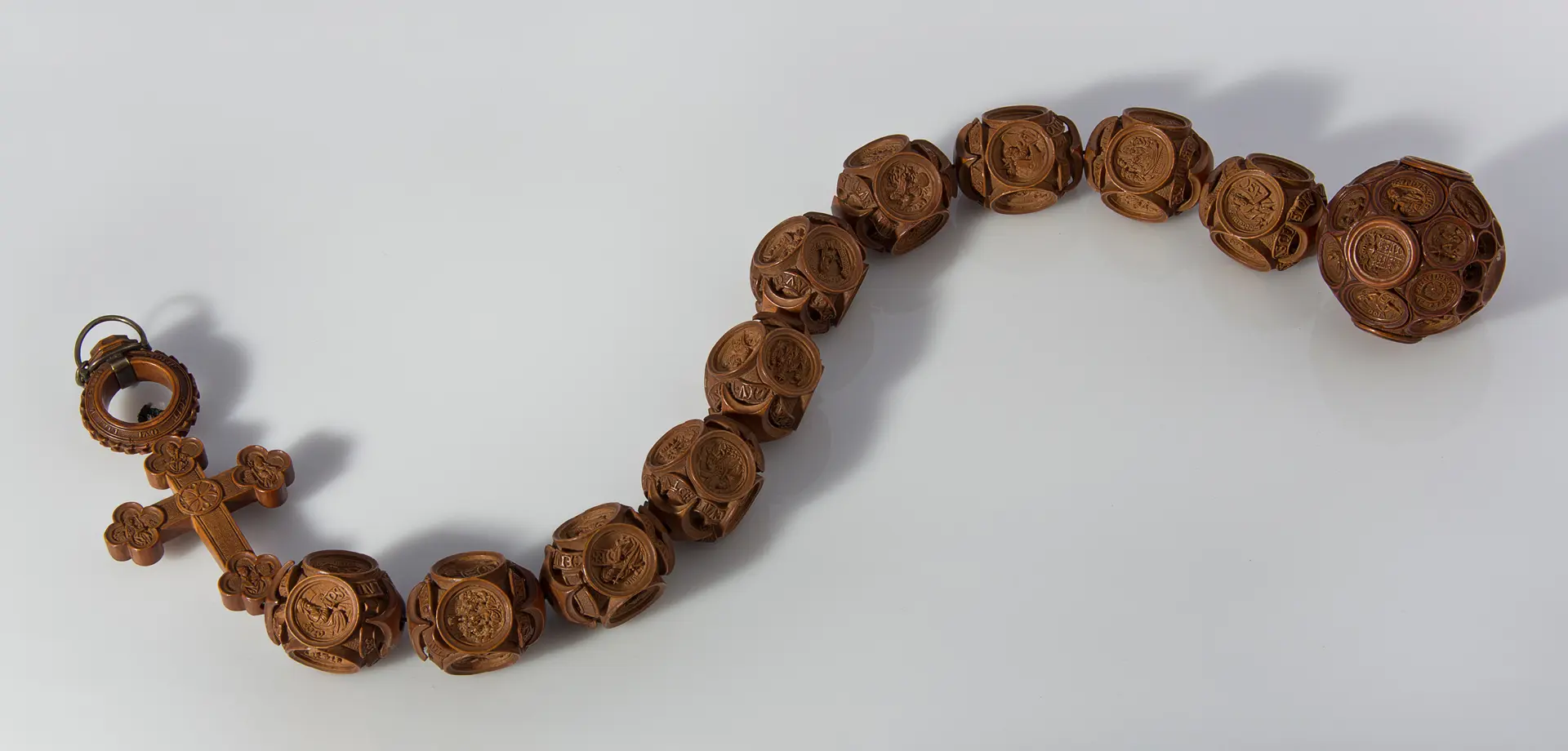We use platforms such as YouTube and Vimeo to display videos. These require the use of cookies, for which we need your consent. To watch this video, please click here to allow cookies.
Prefer to listen? Play the film to hear author Sash Giles read this blog aloud.
The chapel at Chatsworth has been a sacred space for over four hundred years, its walls and ceiling painted with scenes from the life of Christ. Although not used for worship in the 21st century the space retains a feeling of peace and quiet which encourages contemplation.
On display together in 2021 as part of Life Stories were two objects associated with King Henry VIII, a rosary and a modern copy of a preparatory drawing, or cartoon.
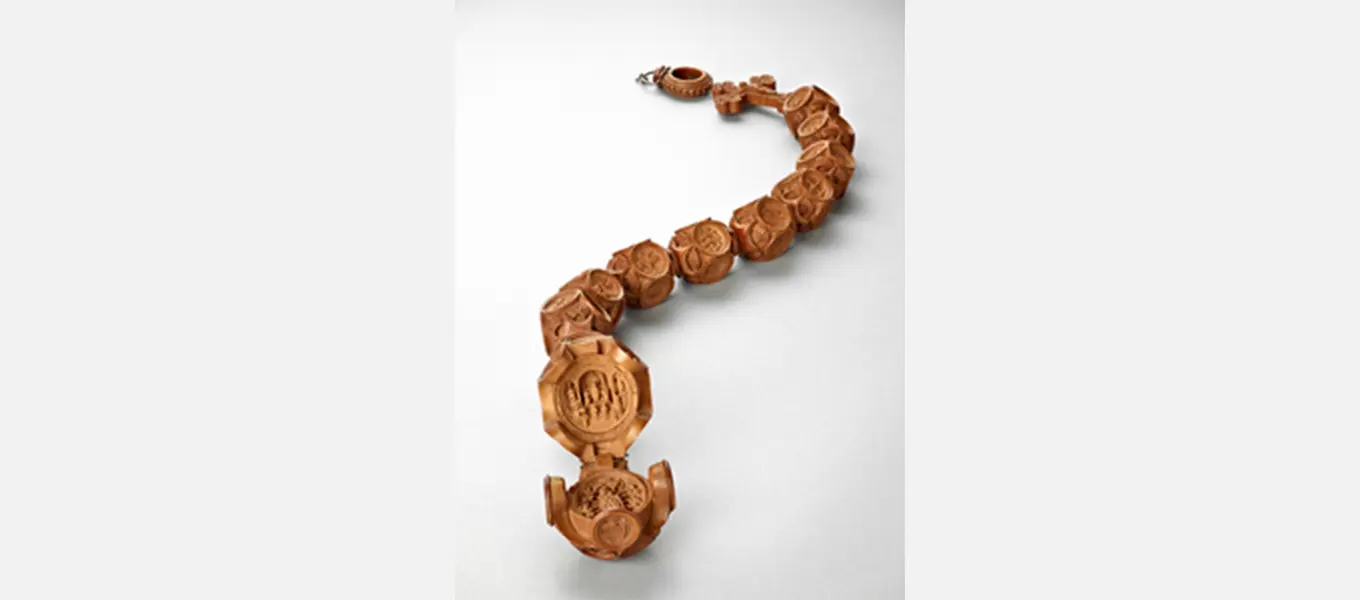
The Chatsworth rosary with the open paternoster bead.
The rosary consists of ten beads, also called a decade and a large bead or paternoster all suspended from a crucifix hanging from a ring. The beads are carved on the outside with three rows of eight roundels, religious scenes, the letters h e 8 and k a for Henry VIII and his wife Katherine (or Catherine) of Aragon, and the royal arms of England.
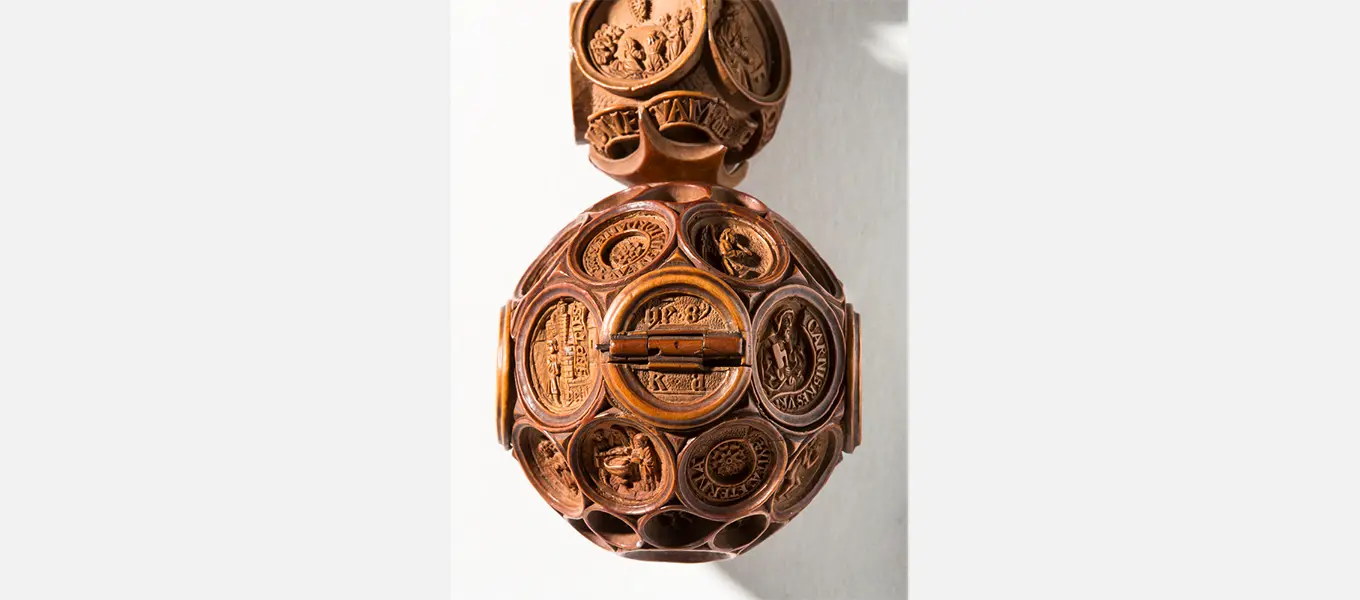
The paternoster bead carved with h e 8 and k a
The paternoster bead is hinged and opens to reveal a carving of the Mass of St Gregory and the Adoration of the Virgin and Child by Angels. The Mass of St Gregory recalls a miracle when he raised the host at mass, and a vision of Christ appeared; seeming proof that at the moment of consecration the bread of the host actually transformed into the body of Christ.
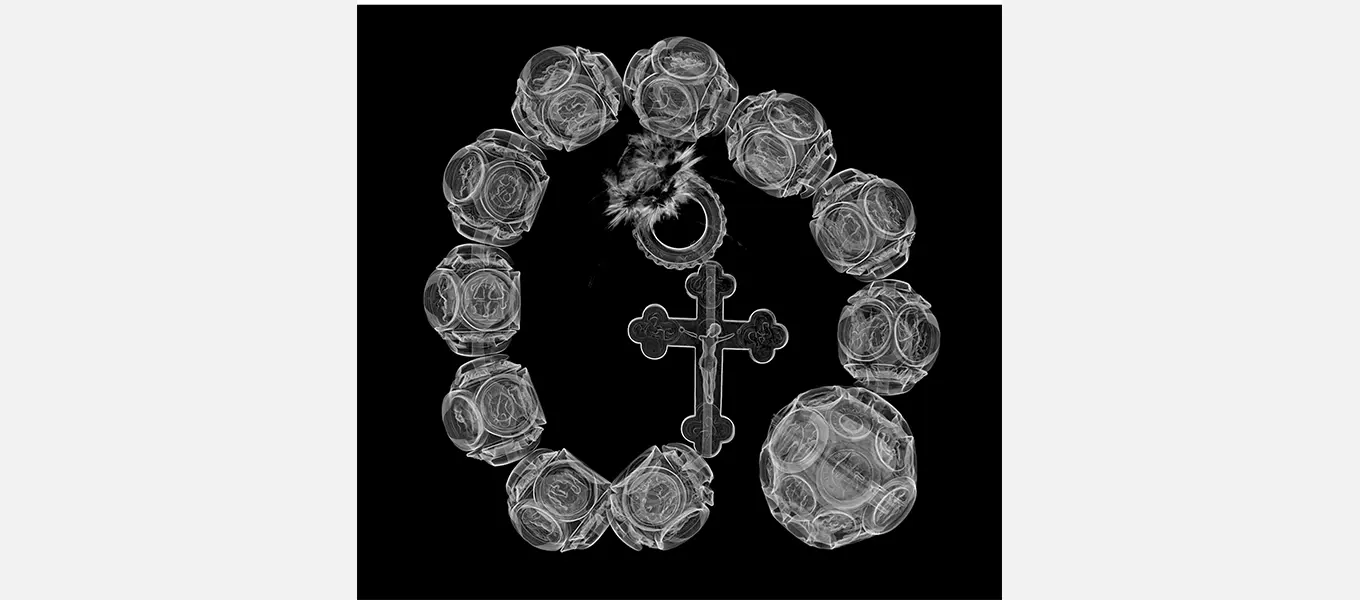
White transparent image of the rosary taken at the Natural History Museum
Making
This rosary dates to between 1509, the year Henry married Katherine of Aragon and 1526 when Henry first began to explore possibilities of annulling their marriage.
The rosary is carved from boxwood which has a compact structure ideal for carving, the wood is firm and takes detailed carving but is not so hard it is too difficult to sculpt. Boxwood is also ideal for an object made to be handled as the wood becomes smoother and polished. It’s likely the rosary was made in a workshop in the Netherlands, one maker of these objects was called Adam Dircksz.
Whoever designed these pieces would have had an understanding of their materials, geometry, the stories and best ways to compose the scenes to convey meaning.
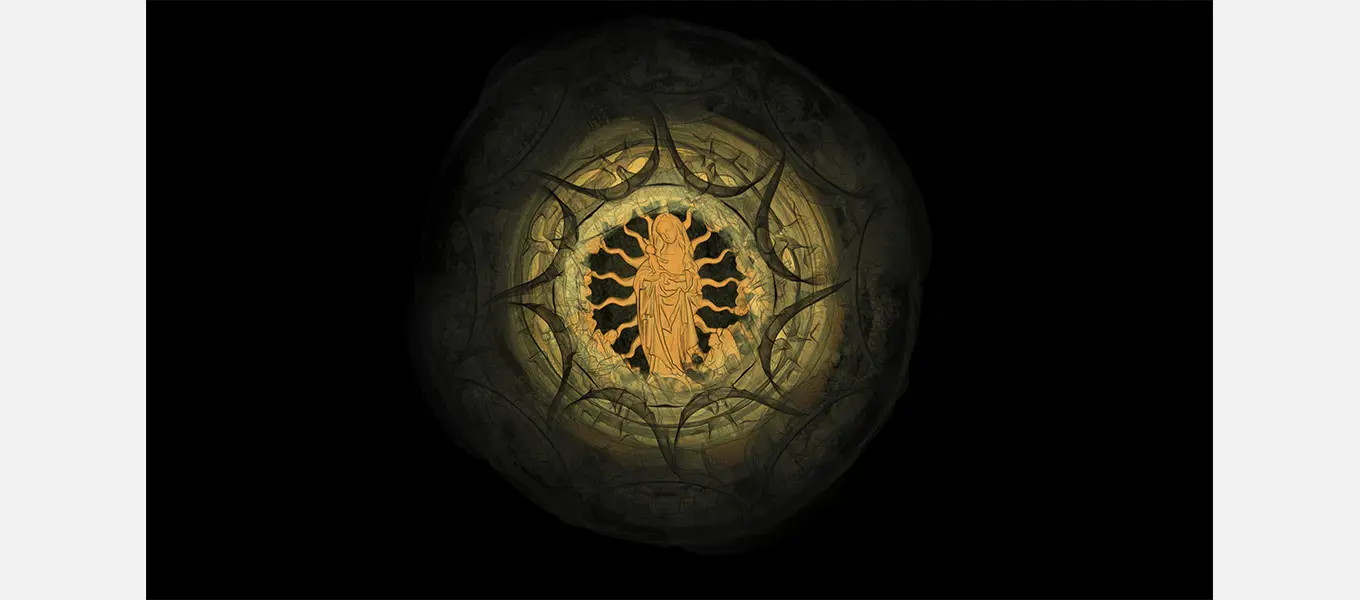
Coloured transparent image also taken at the Natural History Museum
Meaning
Rosaries are personal objects used to concentrate prayer and they are most associated with Catholicism. They come in many forms, made of wood, metal, carved shell, glass or ceramic and are small enough to be carried in the hand or pocket.
The form of praying the Rosary has developed considerably over the centuries. After the reformation the line ‘Holy Mary, Mother of God, pray for us sinners’ was added to the Hail Mary prayer as a response to the damage done to the Catholic church by Henry VIII’s actions.
In seeking a divorce from his first wife Henry became the head of the church in his kingdom, separating it from the Pope and Rome. In doing so he seized wealth and land belonging to religious organisations and set the scene for religious turmoil for centuries to come.
The marriage was finally dissolved in 1533 and Henry outlawed the use of the rosary in 1534 although as the rosary is small and portable it was hard to definitively prevent those who wished to from using it.
Praying of the Rosary is a meditative and contemplative act which concentrates prayer on the mysteries of Christian faith, provoking a deeper and more intimate spiritual experience. It is easy to imagine Henry VIII doing this, running the rosary through his hands, seeking comfort, guidance and perhaps even forgiveness.
Praying the Rosary was never standardised and it still varies depending on which branch of the Catholic faith is adhered to and also by country.
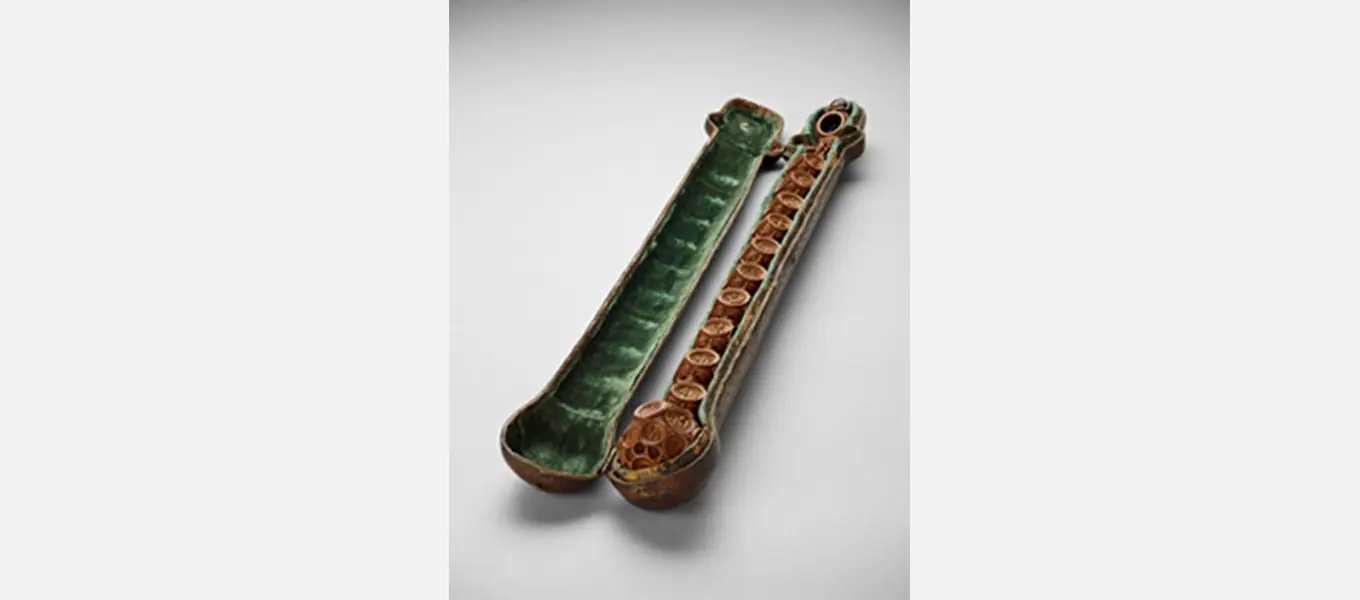
The rosary in its leather, velvet lined fitted case.
Henry VIII’s rosary came to Chatsworth in the 1800s, bought by William, 6th Duke of Devonshire, this extract from the 6th Duke of Devonshire’s handbook, 1844 recalls how:
Since his [Henry VIII’s] time it has belonged to the Pere de la Chaise, who left it to the establishment of the Jesuits at Paris, and, when their goods were sold, it was bought by the Abbé Brotier, editor of Tacitus; and the nephew of Brotier sold it to Messieurs Rundell and Bridge, and they to me. It cost £200. Was that much or little?’.
Pere de la Chaise was a French Jesuit priest who served as confessor to King Louis XIV, the rosary remained in the care of fellow Jesuits, a Catholic order devoted to travelling extensively to minister faith. Rundell and Bridge were a London firm of goldsmiths and jewellers who also dealt in antiques and curiosities, supplying aristocratic and royal clients. £200 is worth approximately £20,000 today.
The cartoon
The preparatory drawing or cartoon displayed in the chapel is a reproduction of the original drawing which was until the 1950s in the Devonshire Collection and was displayed at Hardwick Hall.
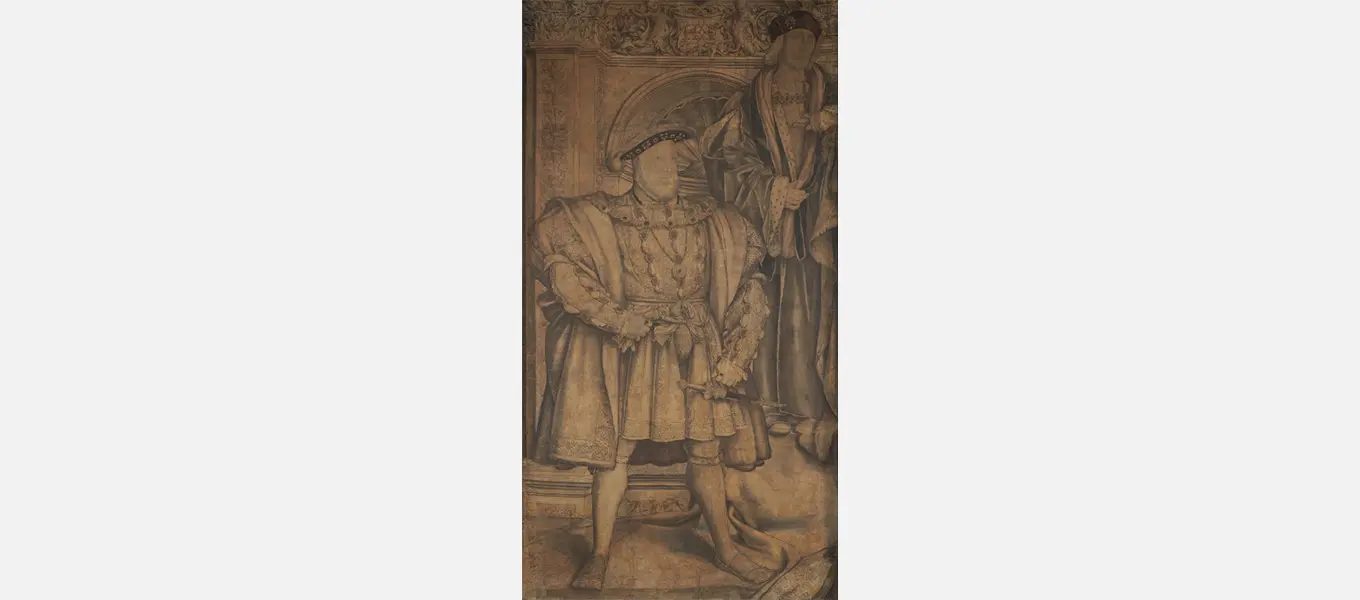
The cartoon prepared for a wall painting at Whitehall Palace.
The cartoon depicts Henry VIII with his father Henry VII behind him, it depicts the Tudor lineage and absent at the time of this drawing was a much hoped for male heir to Henry to continue the Tudor line.
Holbein was commissioned to create a wall-painting for Whitehall Palace; completed in 1537, this may have been in expectation of the birth of Henry VIII's child with Jane Seymour, a son Edward, later Edward VI, born in October 1537.
The depictions of Henry VII and VIII are the first known full length, life size depictions of monarchs in Britain. Karel van Mander, writing in the early 17th century commented that as Henry, “stood there, majestic in his splendour, [he] was so life-like that the spectator felt abashed, annihilated in his presence”. The cartoon and the wall painting were meant to convey a sense of majesty and communicate to the viewer the strength and command of the monarch.
The cartoon is drawn in black ink and watercolour on several sheets of paper joined together and the figures and faces of the kings are cut-outs pasted on to the backing paper. Cartoons would be pricked with pins along the lines of the figures, stuck to a wall and charcoal blown or pushed through the holes to create a traced outline used to guide the painting. This cartoon doesn’t have holes which suggests it was a “best” copy kept to aid further reproductions, perhaps of portraits painted on a smaller scale for framing.
The rosary and cartoon have been reunited for a short time and together they seek to capture something of the emotions and turbulence present in these very different but intertwined works of art.


